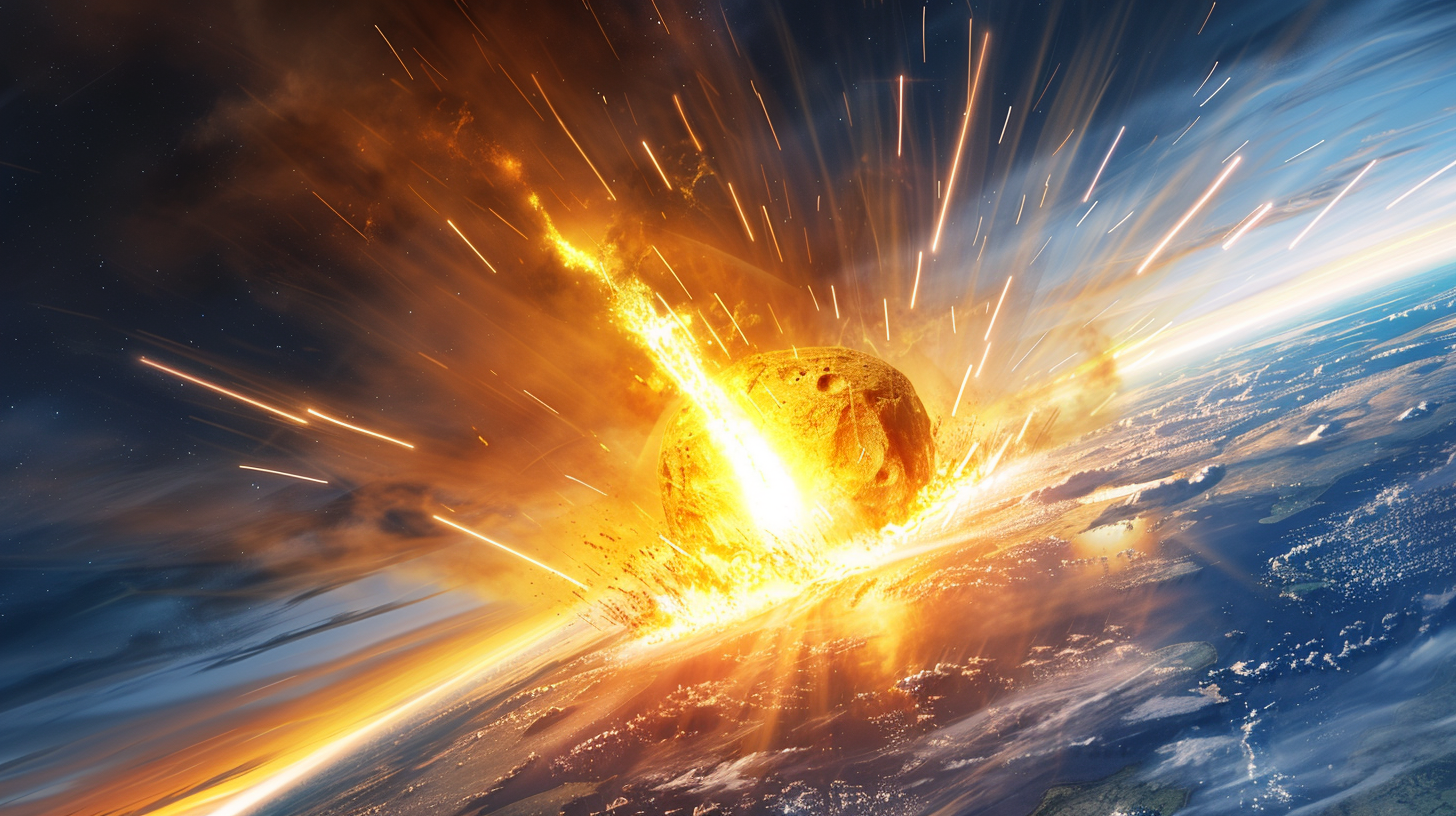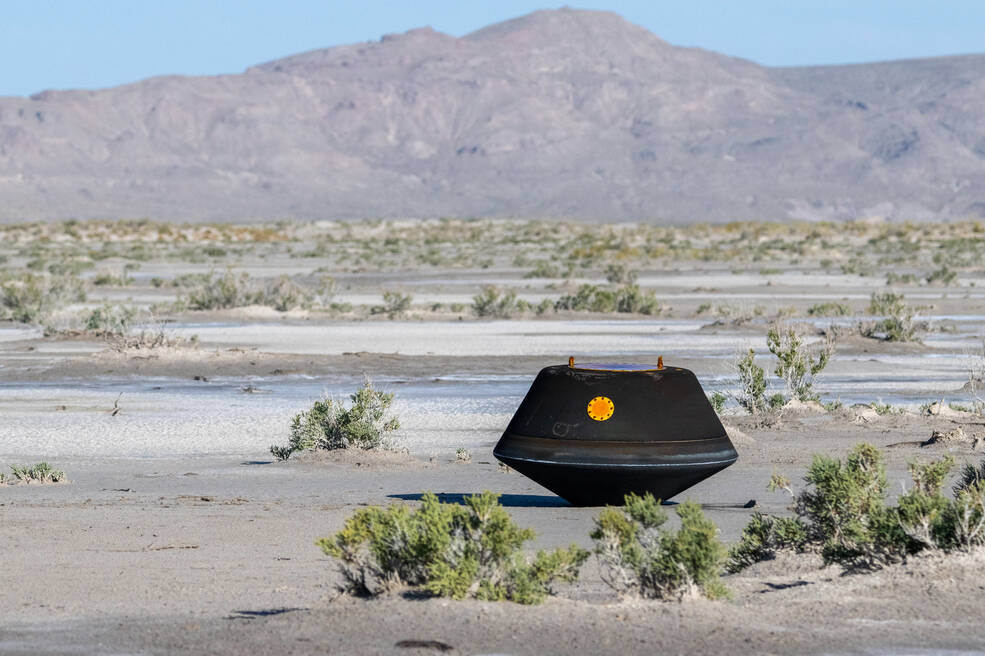Where Will the 2029 Asteroid Hit? 99942 Apophis
The 2029 asteroid, known as 99942 Apophis, has been a topic of intense discussion and for good reason. It’s a massive comet that could potentially impact Earth. However, as per the latest scientific predictions, we can breathe a sigh of relief. This celestial visitor won’t be colliding with Earth. Instead, it’s set to make a close approach, passing us at a safe distance.
This near-Earth encounter of Apophis presents an exciting opportunity for scientific research and discovery. But at the same time, it’s also a stark reminder of the potential threats lurking in the cosmos, and the need for global preparedness and response. Here we’ll take a look at:
- The trajectory of 99942 Apophis
- The potential effects of an asteroid impact
- International strategies for asteroid mitigation.
Discovery and Naming
Asteroid 99942 Apophis first came into our field of observation in 2004. Its name, driven from Egyptian mythology, is representative of the god of chaos – Apophis. Clearly, its near-Earth passage in 2029 has evoked the essence of its namesake, stirring discussions and scientific curiosity across the globe.
With a size roughly equivalent to three football fields, this monstrous space rock has become a focal point for astronomers and researchers. Its close approach on April 13, 2029, will grant us a front-row view of this celestial spectacle. Although, it’s the underlying need for asteroid mitigation strategies that underscores the significance of this event.
| Parameter | Detail |
|---|---|
| Size | Length of three football fields |
| Discovery Year | 2004 |
| Close Approach | April 13, 2029 |
By tracking Apophis’s trajectory, scientific teams can further pave the way to greater understanding and preparedness in interactions with our cosmic neighborhood.
The countdown to 2029 is on. The curtain is yet to rise on the full scope of implications tied to the pass-by of 99942 Apophis. I’m sure we’ll continue to track, learn, and adapt as new information rolls in. Rest assured, the scientific community is not waiting idly for this comet, but rigorously preparing on all fronts.
Size and Distance

Now we look into the specifics – the size and the distance of Apophis from Earth.
Apophis’ quite considerable width of 1,100 feet (340 meters) might be alarming to some, but it’s the asteroid’s proximity on its projected approach that’s generating significant interest.
On April 13, 2029, this asteroid is expected to pass Earth close within 19,794 miles (31,860 kilometers) from our planet’s surface. For context, that is roughly:
- The distance of a round trip from New York to Sydney, Australia
- About three-quarters of the way around the Earth at the Equator
- You could cross the United States coast-to-coast around 9 times
Those might sound far, but also consider that the average distance from the Earth to the Moon is about 238,855 miles (384,400) kilometers. So more or less this thing will come 10x closer to Earth than the Moon.
At its farthest, Apophis can stretch to a distance of 2 Astronomical Units (AU) from Earth.
1 Astronomical Unit signifies the average distance between the Sun and the Earth, so essentially, at its farthest point, the asteroid is twice as far from us as the Sun. That is quite a big orbit.
Through the efforts of NASA, ESA, and various other research groups, attention is now turned to proposals for deflecting Apophis or other similar incoming cosmic threats. We must maximize the time and data at hand, and as 2029 looms, the countdown underscores both the urgency and the challenge.
While this kind of work might spark considerable public interest, it’s key to remember that these efforts are about more than just Apophis. It’s about forging the way to ensure that we’re ready for any potential cosmic threats that might cross our path in the future. To that end, we continue to monitor these close-approaching celestial bodies and build on the valuable insights being generated.
Orbit and Rotation

Clarifying Apophis’s trajectory involves understanding the potential distributions of its important physical parameters like mass and spin. If Apophis turns out to be a light object that rotates in the same direction as its orbit (prograde rotator), the chances of it making contact with Earth are significantly diminished. But, should Apophis be a heavier object with a retrograde rotation, the odds of impact mount considerably.
With ongoing astronomical observations, the possibility of an impact occurring on April 13, 2036, has been reduced to nearly 1 in 250,000. This lower risk ratio is the outcome of path refinement efforts conducted by several key observatories around the globe.
The efforts to deflect Apophis from a potentially devastating path have been varied and far-reaching:
- Tsinghua University in China proposed deploying an impactor spacecraft equipped with a solar sail. The primary aim wouldn’t be to alter the asteroid’s overall course but to prevent it from stumbling onto a possible collision course with Earth.
- Makeyev Rocket Design Bureau in Russia revealed plans to use Intercontinental Ballistic Missiles (ICBMs) to target Apophis and other near-Earth objects.
The key to averting disaster lies not just in shifting Apophis’s course. It also involves significant advancements in our monitoring capabilities and understanding of the cosmos. By enhancing our observational tools, we’ll be in a stronger position to predict – and eventually prevent – potential threats from celestial bodies like Apophis.
Analysis of Potential Impact Locations

To grasp the magnitude of scenarios associated with the potential impact of the asteroid 99942 Apophis, let’s break down the likely strike areas on Earth. Here are the hypothesized impact zones:
Impact Zone 1
The most significant worry is if Apophis were to collide with a populated urban area. The immediate devastating effects and the aftermath would be catastrophic. This could result in:
- Massive loss of life tantamount to the population of the entire city
- Immense property damage leveling entire neighborhoods
- Catapulting debris into the atmosphere would have global repercussive effects on climate.
While this scenario is exceedingly grim, it’s also the least likely one due to the majority of Earth’s surface being water, and significant portions of land being uninhabited.
Impact Zone 2
Let’s presume Apophis strikes an ocean. This scenario, though slightly less devastating, still presents critical issues. Should the asteroid hit deep ocean waters, its impact would cause monumental tsunamis. Seaboard cities could experience:
- Sweeping floods inundating vast areas
- Infrastructure destruction on an immense scale due to water damage
- Massive displacement of coastal communities and marine wildlife disturbance.
The impact wave could potentially reach the farthest corners of the ocean and affect coastal regions globally.
Impact Zone 3
Finally, let’s look at the possibility of Apophis hitting a vast open area, such as a desert or tundra region. The immediate human casualties would be significantly lower in these sparsely populated areas. But, the reverberating effects would still be considerable. An impact here could lead to:
- Intense fires consuming vast expanses of wilderness
- Significant alteration to the landscape creating a crater of notable size
- Knock-on effects on global weather patterns due to dust and debris.
While an impact in these areas would be less directly catastrophic for human populations, the longer-term, global impact may still be significant.
Predicted Consequences
In each scenario of a major comet impact, we’re dealing with significant global repercussions, whether the asteroid lands in an urban area, the ocean, or an open area.
Environmental Impact
The environmental consequences of an asteroid striking Earth depend largely on where it lands. In an open area like a desert, as we’ve discussed earlier, the result could be widespread fires that drastically alter the landscape and release large amounts of particulate matter into the atmosphere. This kind of environmental alteration would have extensive knock-on effects for wildlife in the area and could potentially contribute to global climate change.
If the asteroid were to land in the ocean, the first and most immediate consequence would be the creation of a large-scale tsunami. This would displace enormous volumes of water, leading to flooding along coastlines and severe underwater disturbances that could affect marine life on a large scale.
Such an impact has been put forward in the Younger Dryas hypothesis, where the airbust or impact of a comet led to the rapid mass extinction of Pleistocence megafauna, along with potential ancient, advanced societies.
Human Impact
The human impact of an asteroid strike, while it largely depends on the location of the impact itself, would be catastrophic. Here’s what could happen:
- Massive Explosion: Upon impact, the comet would release energy equivalent to millions of nuclear bombs, causing widespread destruction.
- Global Fires: The heat from the impact could start fires around the globe.
- Tsunamis: If it hit an ocean, it would cause massive tsunamis, engulfing coastal areas.
- Climate Change: Dust and particles thrown up into the atmosphere would block sunlight, leading to a “nuclear winter” effect and global cooling.
- Agricultural Collapse: This cooling and darkness could destroy crops and vegetation, leading to food shortages.
- Ecosystem Disruption: Many species would likely go extinct, including possibly humans, due to the environmental changes.
- Long-term Effects: It would take centuries or longer for the ecosystem to recover.
Infrastructural Damage
Substantial infrastructural damage is to be expected whenever an asteroid the size of 99942 Apophis strikes the Earth. This would lead to huge reconstruction costs and the displacement of people from their homes. Here’s a list of what we would likely experience:
- Immediate Outage: The electromagnetic pulse (EMP) from the impact could fry electronics and satellites, causing an immediate blackout of communications.
- Infrastructure Damage: The physical destruction would take out power lines, cell towers, and other infrastructure.
- Long-term Disruption: It could take years to rebuild the damaged infrastructure, leading to long-term communication and power outages.
- Global Impact: Even areas not directly affected by the impact could experience outages due to interconnected power systems and global communications networks.
Mitigation Strategies
There are various strategies in place to protect our planet from such comet impact threats. These measures include deflection techniques, emergency response plans, and international cooperation.
Deflection Techniques
The proposed strategies for averting such collisions are fascinating, with teams from NASA, ESA, and the Planetary Society focusing on techniques such as Gravitational tractors, kinetic impacts, and nuclear bomb methods.
- A gravitational tractor (I think Star Wars here) is a concept arising from modern astrophysics which aims to divert the course of an object heading towards Earth using the gravitational pull of a spacecraft.
- Kinetic impact methods on the other hand, aim to change the object’s direction by hitting it with a high-speed spacecraft.
- Finally, nuclear bomb methods would entail attempting to shatter or change the asteroid’s course using a nuclear explosion.
Researchers at Tsinghua University have already proposed a mission to knock Apophis onto a safer course using an impactor spacecraft, steered and powered by a solar sail.
Emergency Response Plans
Robust defense systems have been put in place against NEOs (Near Earth Objects), which encompass four key components:
- Telescopic Surveys: These detect and track NEOs.
- Impact Simulations: Used to assess potential collision scenarios.
- Evacuation Protocols: Readiness measures for potential impact events.
- Deflection Missions: Strategies developed to alter NEO paths.
Sustaining and improving these technologies is pivotal to ensure the protection of our planet. With information and preparation, we can observe the cosmos with awe, instead of apprehension.
International Cooperation
Striking a global consensus is key in tackling risks posed by NEOs. Top-tier space agencies like NASA and ESA are known to collaborate on designing missions capable of deflecting these threats. A notable example being the raision-d’être of the Double Asteroid Redirection Test (DART) − a mission developed to test new methods of asteroid deflection.
Educating ourselves about the nature of NEOs and supporting global efforts to enhance our planetary defense system forms an integral part of this try. The role of community efforts and organizational collaborations cannot be overstated in ensuring our safety from extraterrestrial threats.
Conclusion
With the 2029 asteroid in mind, there are a variety of strategies to safeguard our planet. We’ve seen the potential of gravitational tractors, kinetic impacts, and even nuclear bomb methods. It’s clear that we’re not defenseless against Near Earth Objects. We’ve also realized the importance of continuous telescopic surveys, thorough impact simulations, and well-planned evacuation protocols.
The role of international cooperation can’t be understated either. In fact I believe extraterrestrial threats, whether comets or aliens, are the only thing that will get humans to set aside their differences once and for all.
In the face of extraterrestrial threats, we’re not mere spectators. Through proactive measures and international collaboration, we can enhance our planetary defense systems. The 2029 asteroid presents a challenge, but also an opportunity to improve our preparedness for the unknown.





